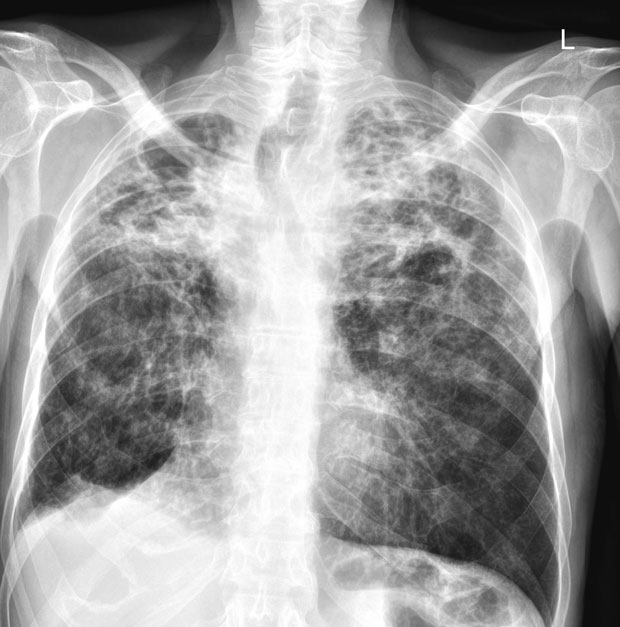MKSAP Quiz: Hospitalization for dyspnea, night sweats, productive cough
A 72-year-old man is hospitalized for dyspnea, night sweats, and productive cough; symptoms began 8 months ago. He also reports a 9.1-kg (20 lb) weight loss over the past 12 months. Medical history is notable for COPD. He has a 60-pack-year smoking history.Medications are umeclidinium and vilanterol inhaler once daily.

On physical examination, vital signs are normal. Pulmonary examination reveals diminished breath sounds. The remainder of the examination is normal.
Sputum Gram stain shows abundant polymorphonuclear cells but no organisms. Sputum acid-fast bacilli stains are positive. Nucleic acid amplification testing for Mycobacterium tuberculosis is negative.
A chest radiograph is shown.
Which of the following is the most likely causative organism?
A. Mycobacterium avium complex
B. Mycobacterium marinum
C. Mycobacterium tuberculosis
D. Streptococcus pneumoniae
Answer and critique
The correct answer is A. Mycobacterium avium complex. This item is Question 30 in MKSAP 19's Infectious Disease section.
The most likely diagnosis in this patient is Mycobacterium avium complex (MAC) infection (Option A). MAC is the most common cause of chronic lung infection worldwide. Cavitary lung disease is seen classically in middle-aged, or older adult men, especially those with underlying lung disease, such as COPD, who smoke cigarettes. Additionally, because of the relatively indolent nature of MAC lung disease, lung destruction may be quite extensive at the time of diagnosis with very large cavities on chest radiograph. The infection is frequently associated with weight loss and night sweats. The chest radiograph generally reveals classic fibrocavitary changes, and respiratory secretions stain positive for acid-fast bacilli. The patient's negative nucleic acid amplification test (NAAT) for Mycobacterium tuberculosis further supports a diagnosis of nontuberculous mycobacterial infection. The definitive diagnosis would be achieved by additional NAAT or molecular probe to identify the mycobacteria and grow the organism for susceptibility testing. A variant of MAC lung disease seen in women older than 50 years who develop bronchiectasis is termed nodular or bronchiectatic MAC because nodules and bronchiectasis are typically seen on chest radiograph.
Mycobacterium marinum (Option B) would be unlikely in this patient. It is a slow-growing, nontuberculous mycobacterium associated with handling fish and cleaning aquariums. M. marinum is in the same group as MAC, M. ulcerans, and M. scrofulaceum; however, this organism is generally associated with ulcerative cutaneous infections and skin and soft tissue infections, not lung disease.
Although Mycobacterium tuberculosis (Option C) should be an initial consideration in the differential diagnosis, the patient's medical history and negative NAAT indicate likely MAC infection rather than M. tuberculosis. Assessing acid-fast bacilli smear-positive specimens with NAAT is highly recommended, with a positive predictive value as high as 95%. The negative result makes a diagnosis of tuberculosis unlikely in this patient. Additionally, in primary pulmonary tuberculosis infection, common radiographic changes include hilar lymphadenopathy and pulmonary infiltrates. Reactivation tuberculosis typically involves the apical-posterior segments of the upper lobes in most patients. However, microbiologic differentiation between organisms is imperative because treatment differs.
Streptococcus pneumoniae (Option D) is a gram-positive, lancet-shaped bacteria that is the most common bacterial cause of community-acquired pneumonia. However, it usually produces an acute infectious process, including acute pneumonia, bacteremia, sepsis, and not infrequently death. It does not produce a chronic lung infection or lung disease. Nonetheless, it is commonly seen as an acute infection in persons with underlying lung disease.
Key Points
- Mycobacterium avium complex infection is a cavitary lung disease classically seen in older adult men with underlying lung disease (e.g., COPD) and a smoking history.
- Fibrocavitary lung disease is a common radiographic presentation of Mycobacterium avium complex infection.



